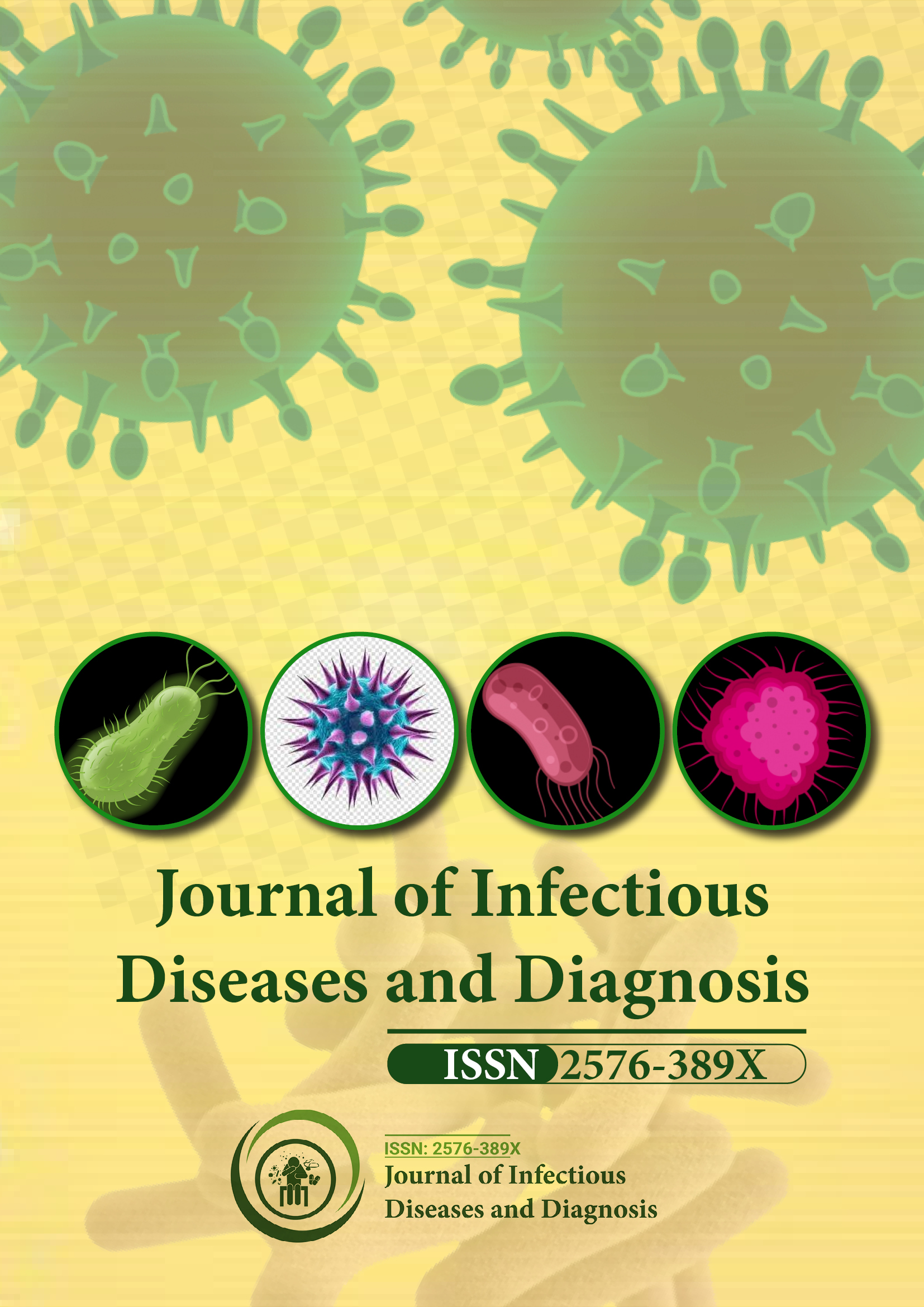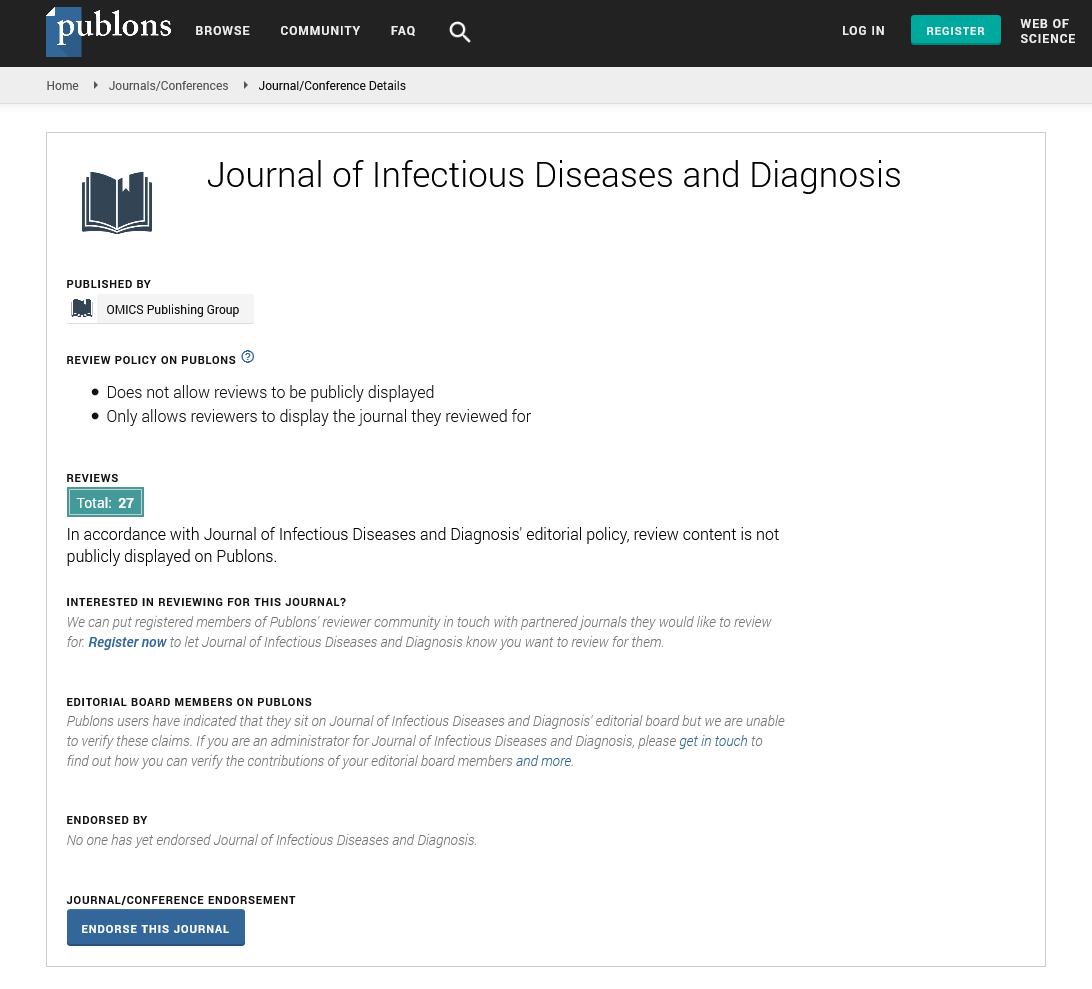Indexed In
- RefSeek
- Hamdard University
- EBSCO A-Z
- Publons
- Euro Pub
- Google Scholar
Useful Links
Share This Page
Journal Flyer

Open Access Journals
- Agri and Aquaculture
- Biochemistry
- Bioinformatics & Systems Biology
- Business & Management
- Chemistry
- Clinical Sciences
- Engineering
- Food & Nutrition
- General Science
- Genetics & Molecular Biology
- Immunology & Microbiology
- Medical Sciences
- Neuroscience & Psychology
- Nursing & Health Care
- Pharmaceutical Sciences
Opinion Article - (2024) Volume 9, Issue 5
Non-Invasive Diagnostic Techniques for Assessing Antimicrobial Resistance in Biofilm-Forming Bacteria
Alex John*Received: 26-Aug-2024, Manuscript No. JIDD-24-26950; Editor assigned: 29-Aug-2024, Pre QC No. JIDD-24-26950 (PQ); Reviewed: 13-Sep-2024, QC No. JIDD-24-26950; Revised: 20-Sep-2024, Manuscript No. JIDD-24-26950 (R); Published: 27-Sep-2024, DOI: 10.35248/2576-389X.24.09.296
Description
Antimicrobial resistance is a growing global health concern, with biofilm-forming bacteria being particularly challenging to treat. Biofilms are clusters of bacteria that adhere to surfaces and are encased in a protective matrix, making them significantly more resistant to antibiotics compared to their planktonic counterparts. These biofilms are commonly found in medical devices, chronic wounds and natural environments, posing serious risks to patient health and treatment efficacy. Traditional methods for diagnosing antimicrobial resistance typically involve invasive techniques, such as tissue biopsies or fluid extraction, which can be uncomfortable, time-consuming and potentially risky for patients. The aim of this article is to explore and evaluate non-invasive diagnostic techniques for assessing antimicrobial resistance in biofilm-forming bacteria. These techniques are important for early detection and monitoring of resistance patterns, ultimately improving patient outcomes and guiding effective treatment strategies.
Non-invasive diagnostic techniques represent a significant advancement in the assessment of antimicrobial resistance in biofilm-forming bacteria, offering a range of sophisticated tools that enhance our ability to monitor and manage these challenging infections. Biofilms, which are communities of bacteria embedded within a protective extracellular matrix, pose a considerable challenge in medical and environmental settings due to their increased resistance to antimicrobial agents. Traditional diagnostic methods often involve invasive procedures such as biopsies or fluid extraction, which can be uncomfortable, risky and time-consuming for patients. In contrast, non-invasive techniques provide valuable insights without the need for direct sampling, making them both patient-friendly and efficient.
Imaging technologies such as Optical Coherence Tomography (OCT) and Confocal Laser Scanning Microscopy (CLSM) play an important role in visualizing biofilms in situ. OCT utilizes light waves to capture high-resolution, cross-sectional images of biofilms, revealing detailed information about their structure, thickness and spatial arrangement. This technique is particularly useful for assessing how biofilms grow and interact with their environment. CLSM, on the other hand, uses laser scanning to produce three-dimensional images of biofilms, allowing for an indepth analysis of bacterial distribution, biofilm density and the interactions between bacterial cells and antimicrobial agents. These imaging techniques provide critical insights into the physical characteristics of biofilms, which can be instrumental in evaluating resistance mechanisms.
Spectroscopy methods offer another powerful approach to noninvasive diagnostics. Raman spectroscopy uses laser light to probe the vibrational modes of molecules within biofilms, providing detailed information about their chemical composition. This technique can detect specific resistance markers and evaluate the presence of antimicrobial agents, offering insights into the molecular basis of resistance. Surface-Enhanced Raman Spectroscopy (SERS) further enhances the sensitivity of Raman spectroscopy by using metal nanoparticles to amplify the Raman signal, allowing for the detection of even low concentrations of bacterial markers or drugs. These spectroscopy methods are invaluable for identifying and characterizing resistance mechanisms at a molecular level.
Biosensors represent an innovative solution for real-time monitoring of biofilm formation and resistance. Electrochemical biosensors detect changes in electrical properties associated with bacterial presence and activity. These sensors can be designed to measure variations in electrical resistance or capacitance caused by biofilm growth or interaction with antimicrobial agents. Optical biosensors use light-based techniques to detect interactions between bacterial cells and specific probes, offering a non-invasive means to assess resistance. By providing continuous or frequent monitoring, biosensors enable timely intervention and adjustment of treatment strategies.
Molecular techniques also contribute significantly to noninvasive diagnostics. Metagenomics involves analyzing the genetic material from biofilm samples obtained through less invasive means, such as surface swabs or environmental samples. This approach provides a comprehensive overview of the microbial community within the biofilm and identifies resistance genes without the need for culturing. Non-invasive Polymerase Chain Reaction (PCR) techniques, such as droplet digital PCR, detect specific resistance genes in biofilm samples, offering precise and sensitive identification of resistance without the discomfort of traditional sampling methods.
Conclusion
Non-invasive diagnostic techniques offer potential alternatives to traditional invasive methods for assessing antimicrobial resistance in biofilm-forming bacteria. Techniques such as optical coherence tomography, Raman spectroscopy and various biosensors provide valuable insights into biofilm structure, chemical composition and resistance patterns. These methods enhance our ability to monitor and manage biofilm-related infections more effectively and with greater patient comfort. Ongoing research and development are essential to improve the sensitivity, specificity and overall performance of non-invasive diagnostic techniques. Integration of these technologies into clinical settings will require validation studies, cost-effectiveness analyses and training for healthcare providers. As these techniques evolve, they hold the potential to revolutionize the management of biofilm-associated infections and contribute to more effective treatment strategies. The advancement of noninvasive diagnostic methods represents a significant step forward in the fight against antimicrobial resistance. By providing detailed and timely information on biofilm formation and resistance, these techniques can enhance clinical decisionmaking, optimize treatment regimens and ultimately improve patient outcomes. Continued innovation and collaboration will be key to harnessing the full potential of non-invasive diagnostics in addressing the complex challenge of antimicrobial resistance.
Citation: John A (2024). Non-Invasive Diagnostic Techniques for Assessing Antimicrobial Resistance in Biofilm-Forming Bacteria. J Infect Dis Diagn. 9:296.
Copyright: © 2024 John A. This is an open-access article distributed under the terms of the Creative Commons Attribution License, which permits unrestricted use, distribution, and reproduction in any medium, provided the original author and source are credited.

